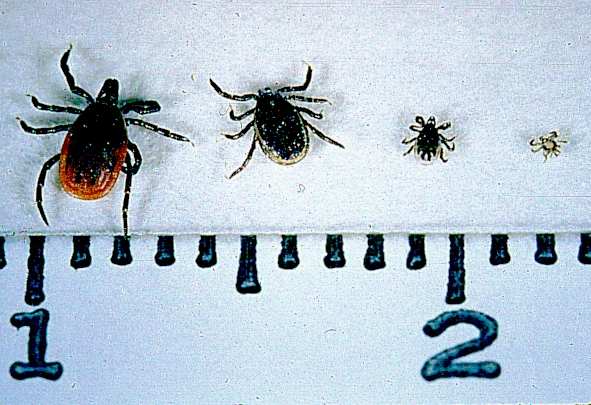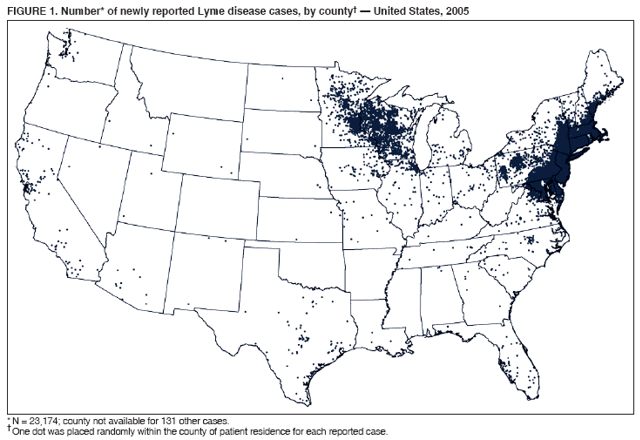Lyme Disease – What’s the Buzz?
What causes it?
Lyme disease is caused by the spiral bacterium known as Borrelia burgdorferi and it is transmitted via a bite from an infected tick. You cannot contract Lyme disease directly from your dog, however in rare cases Lyme disease can be contracted by handling an infected tick removed from your pet.
What species can get it?
It is most commonly seen in dogs but has been reported in cattle, horses, and cats, (and is becoming rampant in the human population as well.) This article pertains only to dogs.
Is my dog at risk?
If you are a client of ours and live in and around Frederick county, then YES. In multiple areas of the country, Lyme disease is becoming an increasing problem in both dogs and humans. The Centers for Disease Control reports that in 2007, 2576 people were diagnosed with Lyme disease in the state of Maryland. For comparison, in 1993, the CDC reported only 180 cases in Maryland. We are in the top 6 states with the highest incidence of Lyme disease in the country. Below is a map (from www.CDC.gov) illustrating the states where Lyme disease in humans is the biggest problem.

Dogs that: spend time in tall grass or woodsy areas, like to go camping or hiking in the mountains, or live in yard that has a lot of shrubbery or that is frequented by wild animals, are at highest risk of being exposed to ticks and contracting Lyme disease. In fact, one out of every 20 dogs tested at our clinic tests positive for Lyme disease. We are seeing it even in dogs that spend very little time outdoors or that live in the city.
What are the symptoms of Lyme disease in dogs?
Only about 5-10% dogs will develop clinical signs, such as lameness, lethargy, or fever. This usually occurs 2-5 months after infection and typically resolves within 3 days. Some dogs get better without antibiotics but some only get better with a course of antibiotics. Less commonly, dogs can develop severe heart, kidney, or neurological problems.
The majority of the dogs that have been exposed to the Lyme bacteria either never develop an active infection, or do so months, sometimes even years after initial exposure.
While most dogs do not develop a severe infection, once your dog has Lyme disease, it will always be in his system with potential to cause severe illness.
How is it detected?
It is diagnosed by a blood test that detects antibodies against a protein (Lyme C6 protein) that is transferred from the infected tick into the dog. However, this test only detects exposure to Lyme disease. It does not tell us if there is an active infection. There is an additional test (quantitative Lyme C6 antibody test) that allows us to differentiate an active infection from exposure. This test actually measures the level of the C6 antibodies – if the levels are high, it means we have an active infection; if the levels are low it means we only have exposure.
 How is it treated?
How is it treated?
Although antibiotics can put the disease into remission, there is no cure for Lyme disease. Even if the active infection is treated the disease will always remain in your pet’s system with potential to come out of dormancy and cause illness because the bacteria actually can hide in your pet’s cartilage.
We treat Lyme disease with the antibiotic, Doxycycline. If your pet is having secondary problems such as joint pain or kidney problems, we may supplement with pain medication or fluid therapy. In more severe cases, an intravenous catheter may be necessary for more critical support. A small percentage of cases unfortunately cannot be treated and succumb to secondary problems, such as kidney failure.
Our recommendations for minimizing your dog’s risk of contracting Lyme disease.
Since there is no cure and the disease, treated or not, can potentially cause chronic problems, prevention is the way to go. We strongly recommend the following:
1) Place your dog on year-round tick preventative and check your dog daily for ticks. Remember, Lyme disease is transmitted via a tick-bite and requires a tick to be attached for at least 48 hours. We recommend year-round applications because our winters often are uncommonly warm – resulting in a year-round tick-friendly environment.


2) Have your dog vaccinated against Lyme disease. Two shots must be given 2 weeks apart initially, then boostered yearly after that. If your dog is older than 6 months and has never received the vaccine before, we should test for Lyme disease prior to the vaccine.
A pet that has previously been treated for Lyme disease can get the vaccine to prevent new infections but the vaccine will not prevent “dormant” infections from coming out of dormancy.
3) Keep your yard tick-free with the following recommendations:
- Keep your yard clean of debris such as leaf litter and grass clippings and keep flowerbeds dry.
- Keep grass mowed, especially at edges of property.
- Trim bushes and shrubs, especially near paths and walkways.
- Minimize ground cover, such as pachysandra.
- Create a 3-foot wide, 3-inch deep barrier using gravel, mulch, or woodchips to separate your lawn from any wooded areas.
- Make sure that areas where children play, including swingsets and playhouses are in dry, sunny areas. You may also want to place gravel, mulch, or woodchips around these areas.
- Any birdfeeders or woodpiles that may attract tick-carrying animals should also be placed in a gravel, mulch, or woodchip surrounded area away from your lawn.
- Preferably, your property, especially the lawn area, should not contain anything designed to attract wildlife, including birdfeeders, birdbaths, and salt licks.
- Mice tend to live in stone walls; keep any stone walls on your property neat. Seal any cracks and clear away nearby debris.
- White-tailed deer have been known to carry hundreds of ticks on their bodies all year round. These deer tend to walk into suburban and rural yards looking for food, and bring those ticks in with them. You may build a fence around your property to keep out deer, or simply avoid attracting them by planting plants deer do not like to eat. Ask your local nursery or garden center for information on “deer proof” plantings.
- You can also apply to low-toxicity pesticide to your property once a year, preferably in May when tick eggs have just hatched. Many pest control agencies specialize in tick control.



